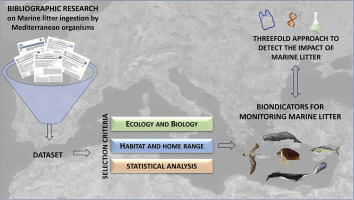Environmental Pollution ( IF 8.9 ) Pub Date : 2017-11-16 , DOI: 10.1016/j.envpol.2017.11.019 Maria Cristina Fossi , Cristina Pedà , Montserrat Compa , Catherine Tsangaris , Carme Alomar , Francoise Claro , Christos Ioakeimidis , Francois Galgani , Tatjana Hema , Salud Deudero , Teresa Romeo , Pietro Battaglia , Franco Andaloro , Ilaria Caliani , Silvia Casini , Cristina Panti , Matteo Baini

|
The Mediterranean Sea has been described as one of the most affected areas by marine litter in the world. Although effects on organisms from marine plastic litter ingestion have been investigated in several oceanic areas, there is still a lack of information from the Mediterranean Sea. The main objectives of this paper are to review current knowledge on the impact of marine litter on Mediterranean biodiversity, to define selection criteria for choosing marine organisms suitable for use as bioindicator species, and to propose a methodological approach to assessing the harm related to marine litter ingestion in several Mediterranean habitats and sub-regions. A new integrated monitoring tool that would provide the information necessary to design and implement future mitigation actions in the Mediterranean basin is proposed.
According to bibliographic research and statistical analysis on current knowledge of marine litter ingestion, the area of the Mediterranean most studied, in terms of number of species and papers in the Mediterranean Sea is the western sub-area as well as demersal (32.9%) and pelagic (27.7%) amongst habitats.
Applying ecological and biological criteria to the most threatened species obtained by statistical analysis, bioindicator species for different habitats and monitoring scale were selected. A threefold approach, simultaneously measuring the presence and effects of plastic, can provide the actual harm and sub-lethal effects to organisms caused by marine litter ingestion. The research revealed gaps in knowledge, and this paper suggests measures to close the gap. This and the selection of appropriate bioindicator species would represent a step forward for marine litter risk assessment, and the implementation of future actions and mitigation measures for specific Mediterranean areas, habitats and species affected by marine litter ingestion.
中文翻译:

监测海洋垃圾摄入及其对地中海生物多样性的影响的生物指标
地中海被世界上海洋垃圾描述为受影响最严重的地区之一。尽管已经在几个海洋地区研究了海洋塑料垃圾摄入对生物的影响,但地中海仍然缺乏信息。本文的主要目的是回顾有关海洋垃圾对地中海生物多样性影响的现有知识,确定选择适合用作生物指示物种的海洋生物的选择标准,并提出一种评估与海洋垃圾有关的危害的方法学方法。摄入了几个地中海生境和次区域。提出了一种新的综合监测工具,该工具将提供设计和实施地中海盆地未来减缓行动所需的信息。
根据书目研究和有关海洋垃圾摄入的最新知识的统计分析,就地中海中物种和纸张数量而言,研究最多的地中海区域是西部区域,也是海底区域(32.9%),在栖息地中有中上层(27.7%)。
根据统计分析得出的最受威胁物种的生态和生物学标准,选择不同生境和监测规模的生物指示剂物种。一种三重方法,同时测量塑料的存在和作用,可以提供因海洋垃圾摄入对生物造成的实际伤害和亚致死作用。该研究揭示了知识方面的差距,本文提出了缩小差距的措施。这种选择和适当生物指示剂物种的选择将代表海洋垃圾风险评估迈出了一步,并为受海洋垃圾摄入影响的特定地中海地区,栖息地和物种实施了未来的行动和缓解措施。



























 京公网安备 11010802027423号
京公网安备 11010802027423号